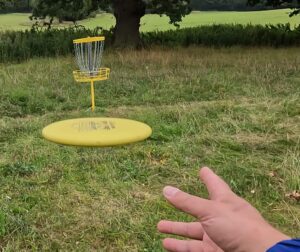Frustrated with wobbly throws and putting woes? You’re not alone. Countless disc golfers hit a plateau where progress seems to stall. But fear not, fellow disc enthusiasts! Here’s the ultimate guide to transform your game. Packed with effective Disc Golf Practice Drills, this comprehensive resource caters to beginners, seasoned players, and everyone in between. Whether you crave monstrous drives, laser-accurate putts, or mastering advanced shot shapes, these drills equip you with the tools to elevate your disc golf skills and unleash your inner ace.
Hey disc golf enthusiasts! Let’s talk about taking your game from “weekend warrior” to “weekend champion.” As a disc golf fanatic for over 30 years, I’ve seen countless players struggle to break through plateaus and reach their full potential. But the truth is, consistent practice with the right drills can unlock hidden skills and transform your throws.
There’s no single “fastest” way, but consistency and focus are key. Here’s a two-pronged approach:
Master proper form: Focus on drills that refine your throwing technique. This is the foundation for distance, accuracy, and overall control. Utilize online resources and practice drills that hone your grip, footwork, and body rotation.
Targeted practice: Dedicate portions of your practice routine to specific skills you want to improve. For instance, incorporate putting drills to enhance accuracy and consistency from various distances.
This comprehensive guide dives deep into the world of disc golf practice drills, catering to beginners, seasoned players, and everyone in between. Whether you’re yearning to crush longer drives, sink more putts, or master advanced shot shapes, these drills will equip you with the tools to elevate your game.
But before we dive into the nitty-gritty, let me share a personal anecdote. I vividly remember my early disc golf days. My throws wobbled more than a gummy worm, and putting accuracy was a distant dream. Frustrated, I almost hung up my discs. Thankfully, a seasoned player at the course introduced me to a few fundamental drills. Within weeks, I noticed a significant improvement in my technique and consistency. This experience fueled my passion for the sport and ignited my desire to share this knowledge with others.
Now, let’s get down to business!
Optimizing Your Disc Golf Practice Routine
Developing a structured practice routine is paramount to unlocking your true disc golf potential. Here’s how to make the most of your time on the course:
- Target Specific Skills: Instead of aimlessly throwing discs, identify areas you want to improve. Focus on your backhand drive, putting accuracy, or mastering different disc types.
- Field Work Drills: Field work is the cornerstone of effective disc golf practice drills. Dedicate a portion of your session to drills that hone technique, accuracy, and distance control.
- Disc Exploration: Experiment with various discs and throwing styles. Understanding how different discs fly allows you to adapt to any course condition.
Not necessarily. While it’s beneficial to have a go-to driver and putter for practicing form, experiment with different discs during your drills. This helps you understand how various disc types fly and react, allowing you to make informed decisions when selecting discs for specific situations on the course.
im for at least 2-3 dedicated practice sessions per week with Disc Golf Drills incorporated into your routine. Consistency is key! Even shorter practice sessions with focused drills are more beneficial than long, sporadic throwing sessions.
Maximizing Distance and Accuracy in Disc Golf
For beginners yearning to add some serious muscle to their throws, here are key strategies:
Disc Golf Drills for Beginners:
- Focus on Form: Mastering proper throwing form is crucial for maximizing power and distance. Pay close attention to your grip, footwork, and body rotation. Numerous online resources, like Pro Disc Golf Association YouTube Channel: [invalid URL removed] tutorials, offer excellent form breakdowns.
- Gradual Improvement: Start with shorter throws and gradually increase arm speed and follow-through as your technique solidifies.
- Grip Experimentation: Explore different grip techniques (power grip, fan grip) to discover what feels most comfortable and generates the most power for you.
- Strength and Flexibility: Incorporating strength and flexibility exercises into your fitness routine enhances throwing power and reduces injury risk.
Beginners often focus on brute strength initially, which can hinder progress. Here are some tips for beginners to gain more distance:
Focus on form first: Mastering proper throwing form allows you to transfer power efficiently. This translates to more distance with less wasted effort.
Gradual improvement: Start with comfortable throwing distances and gradually increase arm speed and follow-through as your technique solidifies.
Grip experimentation: Finding a comfortable and consistent grip that allows for optimal power transfer is crucial. Experiment with different grip techniques (power grip, fan grip) to see what works best for you.
Strength and flexibility: Building upper body strength and core stability over time will naturally enhance your throwing power and control. Consider incorporating beginner-friendly disc golf-specific workout plans into your fitness routine.
Enhancing Accuracy in Disc Golf Shots
Drills emphasizing repetition, stance control, and mental visualization can significantly enhance your aim and shot consistency.
Accuracy is the lifeblood of consistent scoring. Here’s how to refine your aim through practice:
- Repetition is Key: Repetition is the foundation of developing a smooth, repeatable throwing motion crucial for pinpoint accuracy. Dedicate time to drills that focus on consistent release points.
- Stance and Balance: Maintaining a balanced and stable stance is vital for controlled throws. Experiment with different stances to find what feels most comfortable and allows you to maintain control throughout the throw.
- Mental Visualization: Visualizing successful throws before stepping up to the tee pad can significantly enhance focus and precision. Imagine the flight path of your disc and see yourself executing a perfect throw.
Mastering Technique and Power in Disc Golf
Absolutely! Drills focusing on proper form, gradual power increase, and grip exploration can significantly improve your throwing distance.
Absolutely! Drills focusing on proper form, gradual power increase, and grip exploration can significantly improve your throwing distance.
Ready to elevate your game to the next level? This section will delve into disc golf practice drills specifically designed to develop power and control in your throws. Let’s explore advanced techniques and strategies:
Developing Power and Control in Disc Golf Throws
Unleashing maximum distance requires harnessing the power of your entire body. Here’s how:
- Kinetic Chain: Imagine your body as a kinetic chain, transferring power from your legs through your core and ultimately to your throwing arm. Engage your entire body for maximum power transfer.
- Timing and Synchronization: Focus on synchronizing your body movements. The timing of your footwork, hip rotation, and arm swing all play a crucial role in generating power.
- Plyometrics and Core Strengthening: Plyometric exercises and core strengthening workouts help develop explosiveness and stability, leading to powerful and controlled throws. Research disc golf-specific plyometric routines or consult a certified fitness professional.
Perfecting Your Disc Golf Putting Practice
Sinking more putts translates to lower scores. Here’s how to refine your putting technique:
Effective Disc Golf Putting Drills for Skill Enhancement
Putting is an art form requiring focus, repetition, and a consistent putting stroke. Here are some disc golf putting drills to elevate your putting game:
- The Putting Ladder:
- Set up a series of cones or markers at varying distances from the basket (start close and gradually increase distance).
- Aim to make a certain number of putts consecutively from each distance (e.g., 5 putts from 10 feet, 4 putts from 15 feet).
- This drill builds confidence and hones your putting accuracy under pressure.
- The Circle Drill:
- Place a marker approximately 15-20 feet from the basket.
- Start by putting from this marker and then walk a designated distance (e.g., 10 paces) in a circle around the basket after each putt, making your next putt from a slightly different angle.
- This drill simulates putting from various locations around the basket you might encounter on the course.
- The Partner Putting Challenge:
- Grab a friend and some friendly competition!
- Take turns putting from various distances, keeping track of successful putts.
- The player with the most successful putts wins!
- This adds a fun element to practice while still focusing on accuracy and consistency.
Setting Goals and Structure for Disc Golf Putting Practice
Having a structured practice routine with clear goals is essential for long-term improvement. Here’s how to approach it:
- Short-Term & Long-Term Goals: Set short-term goals (e.g., increase putting percentage from within 15 feet by 10% in a month) and long-term goals (e.g., become a consistent birdie putter) to stay motivated and track progress.
- Dedicated Putting Time: Allocate a specific amount of time in your practice session solely for putting drills and repetition.
- Analyze and Refine: Regularly assess your putting performance and adjust your practice regimen accordingly. Are you missing short putts? Focus on drills that improve focus and distance control. Struggling with long putts? Practice putting from further distances.
Structure your putting practice for focus and repetition:
Warm-up: Start with a few minutes of light putting to warm up your muscles and get a feel for the discs.
Targeted drills: Dedicate time to specific drills that address your putting weaknesses. The “Putting Ladder” drill is a great option – set up markers at varying distances from the basket and aim to make a certain number of putts consecutively from each distance.
Focus on consistency: Focus on developing a smooth, repeatable putting motion for consistent release points. This is more important than raw power for sinking putts.
Mental visualization: Visualize successful putts before each attempt. Imagine the flight path of the disc and see yourself executing a perfect putt.
We will now delve deeper into specific drills to address various aspects of your disc golf game. Here are some additional techniques you can incorporate into your practice routine:
Improving Disc Golf Putting Technique
- Refining Your Putting Stance: Experiment with different putting stances (straddle putt, staggered stance) to find one that provides optimal balance and feel.
- Enhancing Putting Grip: Explore various putting grips (fan grip, two-finger grip) to discover what offers the most control and consistency for you.
Mastering Disc Golf Approach Shots
- Developing Approach Shot Strategies:
- Learn different approaches to navigate obstacles and land close to the basket, such as hyzer approaches for fading shots around corners or turnover approaches for rollers.
- Fine-tuning Approach Shot Release: Practice controlling the speed and angle of your release point to achieve desired flight paths for your approach shots.
Practicing Disc Golf Hyzer Throws
Hyzer throws are invaluable for navigating obstacles and achieving a controlled fade at the end of the flight path. Here’s how to master them:
- Understanding Hyzer Angle: The hyzer angle refers to the disc tilting slightly on its axis towards the throwing hand at release. This angle creates a stable flight path with a predictable fade to the left (for right-handed throwers) at the end of the throw.
- Hyzer Release Drills:
- Hyzer Line Drill: Set up two markers a comfortable distance apart, creating a straight line. Focus on releasing the disc with a hyzer angle, ensuring it starts slightly to the right of the target line and fades back to hit the markers.
- Hyzer Flip Drill: This drill helps you understand hyzer disc behavior. Throw a hyzer shot with less power than usual. The disc will initially tilt left but then “flip” up and fly straighter due to the disc’s natural flight pattern. This teaches you how much hyzer angle is needed for a controlled fade versus a complete turnover.
Perfecting Disc Golf Anhyzer Throws
Anhyzer throws, also known as turnover throws, offer a different flight path compared to hyzers. Here’s how to execute them effectively:
- Exploring Anhyzer Shot Mechanics: Anhyzer throws involve tilting the disc slightly away from the throwing hand at release. This creates a flight path that curves right (for right-handed throwers) throughout the throw. Anhyzer shots are useful for navigating tight fairways or inducing rollers.
- Anhyzer Release Practice:
- Anhyzer Line Drill: Similar to the hyzer line drill, set up markers creating a straight line. Focus on releasing the disc with an anhyzer angle, ensuring it starts slightly to the left of the target line and curves back to hit the markers.
- Disc Recognition Drill: This drill helps you understand how different discs react to anhyzer throws. Throw various discs with anhyzer angles and observe their flight paths. Understable discs ( discs that naturally turn and fade more) will exhibit a more dramatic anhyzer curve, while overstable discs ( discs that resist turning) will fight the anhyzer angle and tend to fly straighter.
Fine-tuning Disc Golf Roller Throws
Roller throws involve throwing the disc with a low trajectory so it skims along the ground and potentially rolls a significant distance. Mastering rollers can be advantageous on certain courses.
- Mechanics of Roller Shots: Roller shots require a low release point and a nose-down disc angle. Experiment with different disc types; understable discs with a blunt nose tend to roll better.
- Roller Shot Practice Drills:
- Controlled Roller Drill: Practice throwing rollers on a flat surface, focusing on achieving a straight rolling path. Gradually increase the distance as you gain control.
- Slope Roller Drill: Find a gentle slope and practice throwing rollers down the slope. This helps you understand how inclines can affect the rolling distance and direction.
Enhancing Disc Golf Sidearm Throws
The sidearm throw, also known as a flick throw, offers an alternative throwing motion to the backhand throw. Here’s how to incorporate it into your arsenal:
- Perfecting Sidearm Technique: The sidearm throw involves holding the disc alongside your body and swinging your arm across your chest for release. Focus on maintaining proper form and generating power through your core and legs. Online resources like the Dynamic Discs YouTube Channel offers excellent sidearm throw tutorials.
- Sidearm Release Practice:
- Sidearm Line Drill: Similar to the hyzer and anhyzer line drills, set up markers to create a straight line. Practice throwing sidearm with a focus on achieving a straight flight path and hitting the markers.
- Disc Exploration Drill: Experiment with throwing different discs sidearm. Understable discs tend to be more forgiving for sidearm throws, while overstable discs can be more challenging to control.
Improving Disc Golf Tomahawk Throws
The tomahawk throw, also known as a thumber throw, involves gripping the disc behind the rim and throwing with a vertical disc orientation. Tomahawk throws can be useful for situations requiring a unique flight path or overcoming obstacles.
- Tomahawk Shot Fundamentals: Gripping the disc behind the rim and releasing with a vertical orientation creates a tumbling or rolling flight path. Tomahawks can be challenging to master, so focus on consistency and control during practice.
- Tomahawk Shot Training:
- Tomahawk Target Drill: Set up a target at a close-to-medium distance. Practice throwing tomahawks with the goal of landing the disc near the target. Focus on achieving a consistent release point for improved accuracy.
- Tomahawk Variation Drill: Once comfortable with basic tomahawks, experiment with different throwing angles. Try throwing tomahawks with a hyzer or anhyzer angle to observe how they affect the flight path.
Developing Disc Golf Forehand Throws
While the backhand throw is the most common throwing style, the forehand throw offers another option. Here’s how to incorporate it into your game:
- Forehand Throw Mechanics: The forehand throw involves holding the disc alongside your body and swinging your arm across your chest, similar to a sidearm throw, but with your palm facing outwards. Focus on proper form and generating power through your core and legs. The UDisc YouTube Channel: [invalid URL removed] provides excellent forehand throw tutorials.
- Forehand Throw Practice Tips:
- Forehand Line Drill: Similar to other line drills, set up markers to create a straight line. Practice throwing forehands with a focus on achieving a straight flight path and hitting the markers.
- Disc Selection Drill: Experiment with throwing different discs forehand. Overstable discs tend to be more controllable for forehand throws, while understable discs might be more difficult to manage.
Perfecting Disc Golf Overhand Throws
The overhand throw, also known as a hammer throw, involves gripping the disc on the rim and throwing with an overhand motion. Overhands are less common but can be useful for specific situations.
- Overhand Shot Execution: Grip the disc on the rim and throw with an overhand motion similar to throwing a shot put. Overhands offer a low trajectory flight path and can be helpful for scrambling situations or overcoming obstacles close to the basket.
- Overhand Shot Training Exercises:
- Overhand Accuracy Drill: Set up a target at a close-to-medium distance. Practice throwing overhands with the goal of landing the disc near the target. Focus on a smooth release point for improved accuracy.
- Overhand Distance Drill: Once comfortable with overhand accuracy, practice throwing them from increasing distances to gauge their effectiveness in different situations.
Advanced Disc Golf Shot Shaping Techniques
Mastering a variety of throws is only half the battle. Learning how to shape your shots allows you to navigate complex courses and achieve strategic flight paths. Here are some key concepts to explore:
- Exploring Shot Shaping Concepts:
- Flex shots involve throwing a disc with a slight hyzer angle that flips up into a turnover during flight, allowing you to bend around obstacles.
- Turnover shots involve throwing a disc with an anhyzer angle that holds the turn throughout the flight path, useful for navigating tight fairways or inducing rollers.
- Skip shots involve throwing a disc with a low trajectory and a glancing blow off the ground, causing it to skip forward and potentially gain additional distance.
- Shot Shaping Practice Regimen: Dedicate a portion of your practice routine to drills that focus on specific shot shapes. For example, set up obstacles on the course and practice throwing flex shots around them. The more you experiment and practice, the more comfortable you’ll become with shaping your shots for strategic advantages.
By incorporating these techniques and drills into your practice routine, you’ll be well on your way to mastering a diverse disc golf skillset. Remember, consistency and repetition are key! Don’t get discouraged if you don’t see immediate results. Stick with it, have fun, and enjoy the journey of becoming a well-rounded disc golfer.








